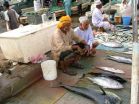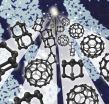(Press-News.org) Defects damage the ideal properties of many two-dimensional materials, like carbon-based graphene. Phosphorus just shrugs.
That makes it a promising candidate for nano-electronic applications that require stable properties, according to new research by Rice University theoretical physicist Boris Yakobson and his colleagues.
In a paper in the American Chemical Society journal Nano Letters, the Rice team analyzed the properties of elemental bonds between semiconducting phosphorus atoms in 2-D sheets. Two-dimensional phosphorus is not theoretical; it was recently created through exfoliation from black phosphorus.
The researchers compared their findings to 2-D metal dichalcogenides like molybdenum disulfide; these metal compounds have also been considered for electronics because of their inherent semiconducting properties. In pristine dichalcogenides, atoms of the two elements alternate in lockstep. But wherever two atoms of the same element bond, they create a point defect. Think of it as a temporary disturbance in the force that could slow electrons down, Yakobson said.
Semiconductors are the basic element of modern electronics that direct and control how electrons move through a circuit. But when a disturbance deepens a band gap, the semiconductor is less stable. When chaos reigns in the form of multiple point defects or grain boundaries -- where sheets of a 2-D material merge at angles, forcing like atoms to bond – the materials become far less useful.
The Yakobson lab's calculations show phosphorus has no such problem. Even when point defects or grain boundaries exist, the material's semiconducting properties are stable. Like perfect graphene – but unlike imperfect graphene -- it performs as expected.
View 2-D phosphorus from above and it looks like graphene, boron nitride or other dichalcogenides, with its rows of hexagons. But at an angle, phosphorus reveals its true form, as alternate atoms jut out of the matrix. This complexity gives rise to more variations among the defects, Yakobson said.
"Because 2-D phosphorus has only one type of element, its defects do not contain hetero-elemental 'wrong' bonds," said Yuanyue Liu, the paper's first author and a Rice alumnus, now a postdoctoral researcher at the National Renewable Energy Laboratory. "These bonds would not trap or recombine electrons or holes.
"This is a good property for application in solar cells," he said. "Two-D phosphorus could potentially be used to harvest sunlight, as its band gap matches well with the solar spectrum." Unlike conventional absorbers, he said, the presence of defects would not deteriorate the material's performance.
The researchers also show it may be possible to tune the electronic properties of 2-D phosphorus by altering (aka doping) it with foreign atoms. This should be of value to electronics manufacturers, Yakobson said. Carbon and zinc may boost positive conductivity, while potassium may increase negative conductivity; the researchers believe phosphorus may be a promising anode material for batteries.
In fact, 2-D phosphorus has more in common with three-dimensional silicon, the most common element in semiconducting electronics like computer chips. As in 2-D phosphorus, grain boundaries in silicon don't cause band-gap changes. However, point defects in silicon can change its properties, unlike point defects in phosphorus.
This suggests 2-D phosphorus could also be a candidate for high-performance electronics. In fact, Liu said, several experimental reports have already shown it can be a better transistor than 2-D metal dichalcogenides.
The researchers noted that phosphorus is abundant and black phosphorus can be made relatively easily, but phosphorus reacts slowly with oxygen. To make it practical for daily applications, it has to be well-sealed, Liu said.
INFORMATION:
The paper's co-authors include graduate students Fangbo Xu and Ziang Zhang and research scientist Evgeni Penev, all of Rice. Yakobson is Rice's Karl F. Hasselmann Professor of Materials Science and NanoEngineering, a professor of chemistry and a member of Rice's Richard E. Smalley Institute for Nanoscale Science and Technology.
The Department of Energy supported the research. The researchers used the Data Analysis and Visualization Cyberinfrastructure supercomputer supported by the National Science Foundation (NSF) and administered by Rice's Ken Kennedy Institute for Information Technology, as well as NSF's XSEDE and the Department of Energy's National Energy Research Scientific Computing Center supercomputers.
Read the abstract at http://pubs.acs.org/doi/abs/10.1021/nl5021393
Follow Rice News and Media Relations via Twitter @RiceUNews
Related Materials:
Yakobson Research Group: http://biygroup.blogs.rice.edu
Rice University Materials Science and NanoEngineering: http://msne.rice.edu
Images for download:
http://news.rice.edu/wp-content/uploads/2014/09/0908_PHOSPHORUS-3-web.jpg
A point defect appears in a two-dimensional material when atoms don't line up quite right, as in the puckered pair of a heptagon and a pentagon seen at top. In many materials, this disruption of regular six-atom rings (as seen at bottom) would change the material's electronic properties. But Rice University theorists have determined that 2-D phosphorus would not be affected by such defects. (Credit: Evgeni Penev/Rice University)
http://news.rice.edu/wp-content/uploads/2014/09/0908_PHOSPHORUS-2-web.jpg
Grain boundaries are rows of defects that disrupt the electronic properties of two-dimensional materials like graphene, but new theory by scientists at Rice University shows no such effects in atomically flat phosphorus. That may make the material ideal for nano-electronic applications. (Credit: Evgeni Penev/Rice University)
Located on a 300-acre forested campus in Houston, Rice University is consistently ranked among the nation's top 20 universities by U.S. News & World Report. Rice has highly respected schools of Architecture, Business, Continuing Studies, Engineering, Humanities, Music, Natural Sciences and Social Sciences and is home to the Baker Institute for Public Policy. With 3,920 undergraduates and 2,567 graduate students, Rice's undergraduate student-to-faculty ratio is just over 6-to-1. Its residential college system builds close-knit communities and lifelong friendships, just one reason why Rice is highly ranked for best quality of life by the Princeton Review and for best value among private universities by Kiplinger's Personal Finance.
Phosphorus a promising semiconductor
Rice University physicists find 2-D form pays no heed to defects
2014-09-09
ELSE PRESS RELEASES FROM THIS DATE:
A system that facilitates malware identification in smartphones
2014-09-09
Malware is a type of malicious program whose general aim is to profit economically by carrying out actions without the user's consent, such as stealing personal information or committing economic fraud. We can find it "in any type of device ranging from traditional cell phones to today's smartphones, and even in our washing machine," explained one of the researchers, Guillermo Suarez de Tangil, from the Computer Science Department at UC3M.
With the massive sales of smartphones in recent years (more than personal computers in all of their history), malware developers ...
Testing the fossil record
2014-09-09
Palaeontologists have developed methods to try to identify and correct for bias and incompleteness in the fossil record. A new study, published on 4 September 2014 in the journal Nature Communications, suggests that some of these correction methods may actually be misleading. The work is led by Dr Alex Dunhill (University of Leeds, formerly at the Universities of Bath and Bristol), together with Hannisdal (University of Bergen) and Professor Michael Benton (University of Bristol).
Back to the origin of animals
"The Earth keeps changing. Life keeps evolving. And there ...
How age alters our immune response to bereavement
2014-09-09
Young people have a more robust immune response to the loss of a loved one, according to new research from the University of Birmingham, providing insight into how different generations cope with loss.
The study, published in the journal Immunity and Ageing, shows how the balance of our stress hormones during grief changes as we age – meaning elderly people are more likely to have reduced immune function and, as a result, suffer from infections.
It is the first research to compare different generations and display the relationship between stress hormones and immune ...
Myriad myPath™ melanoma test reduced indeterminate cases by 76 percent
2014-09-09
SALT LAKE CITY, Utah, Sept. 9, 2014 – Myriad Genetics, Inc. (Nasdaq: MYGN) today presented results from a pivotal clinical utility study of the Myriad myPath™ Melanoma test at the 2014 College of American Pathologists (CAP) annual meeting in Chicago, Ill. Myriad myPath Melanoma is a novel diagnostic test that differentiates malignant melanoma from benign skin lesions with greater than 90 percent accuracy and helps physicians deliver a more objective and confident diagnosis for patients.
This study evaluated the impact of the myPath Melanoma diagnostic test on expert ...
Biologists try to dig endangered pupfish out of its hole
2014-09-09
Berkeley — Scientists estimate that fewer than 100 Devils Hole pupfish remain in their Mojave Desert home, but a conservation biologist at the University of California, Berkeley, is giving important guidance in the efforts to rescue them by establishing a captive breeding program.
Considered the world's rarest fish, with one of the smallest geographic ranges of any wild vertebrate, the tiny pupfish (Cyprinodon diabolis) – about one-inch long as an adult – neared extinction in spring 2013 when populations dropped to an all-time low of 35 observable pupfish. While more ...
Tracing water channels in cell surface receptors
2014-09-09
G protein-coupled receptors (GPCRs) are the largest class of cell surface receptors in our cells, involved in signal transmission across the cell membrane. One of the biggest questions is how a signal recognized at the extracellular side of a GPCR induces a sequence of conformational changes in the protein and finally evokes an intracellular response. EPFL scientists have now used computer modeling to reveal in molecular detail the structural transitions that happen inside GPCRs during the signal transduction process. They discovered that a central step in the trans-membrane ...
Shift in Arabia sea plankton may threaten fisheries
2014-09-09
A growing "dead zone" in the middle of the Arabian Sea has allowed plankton uniquely suited to low-oxygen water to take over the base of the food chain. Their rise to dominance over the last decade could be disastrous for the predator fish that sustain 120 million people living on the sea's edge.
Scientists at Columbia University's Lamont-Doherty Earth Observatory and their colleagues are the first to document the rapid rise of green Noctiluca scintillans, an unusual dinoflagellate that eats other plankton and draws energy from the sun via microscopic algae living within ...
Buckyballs and diamondoids join forces in tiny electronic gadget
2014-09-09
Menlo Park, Calif. — Scientists have married two unconventional forms of carbon – one shaped like a soccer ball, the other a tiny diamond – to make a molecule that conducts electricity in only one direction. This tiny electronic component, known as a rectifier, could play a key role in shrinking chip components down to the size of molecules to enable faster, more powerful devices.
"We wanted to see what new, emergent properties might come out when you put these two ingredients together to create a 'buckydiamondoid,'" said Hari Manoharan of the Stanford Institute for Materials ...
Eating habits, body fat related to differences in brain chemistry
2014-09-09
People who are obese may be more susceptible to environmental food cues than their lean counterparts due to differences in brain chemistry that make eating more habitual and less rewarding, according to a National Institutes of Health study published in Molecular Psychiatry.
Researchers at the NIH Clinical Center found that, when examining 43 men and women with varying amounts of body fat, obese participants tended to have greater dopamine activity in the habit-forming region of the brain than lean counterparts, and less activity in the region controlling reward. Those ...
Study sheds light on how stem cells can be used to treat lung disease
2014-09-09
Munich, Germany: A new study has revealed how stem cells work to improve lung function in acute respiratory distress syndrome (ARDS).
Previous studies have shown that stem cells can reduce lung inflammation and restore some function in ARDS, but experts are not sure how this occurs. The new study, which was presented at the European Respiratory Society's International Congress today (09 September 2014), brings us a step closer to understanding the mechanisms that occur within an injured lung.
ARDS is a life-threatening condition in which the efficiency of the lungs ...
LAST 30 PRESS RELEASES:
Australian team discover why quantum computers have memory problems over time
What determines the fate of a T cell?
Candida auris: genetic process revealed which could be treatment target for deadly fungal disease
Groundbreaking discovery turns household plastic recycling into anti-cancer medication
Blocking a key inflammatory pathway improves liver structure and vascular function in cirrhosis, study finds
Continuous spread: Raccoon roundworm detected in nine European countries
HKUST Engineering researchers developed a novel photodetector to enhance the performance of on-chip light monitoring
Strategic river sensors could have forewarned of Texas Camp flood disaster
Drone sampling of whale breath reveals first evidence of potentially deadly virus in Arctic
Roman soldiers defending Hadrian’s Wall infected by parasites, study finds
Pinochet’s prisoners were tormented with music but still found solace in it, a new book reveals
Fertility remains high in rural Tanzania despite access to family planning
AI-assisted device can improve autism care access
Kinetic careers
Uncovering how parasitic plants avoid attacking themselves to improve crop resistance
Nanoparticle vaccine strategy could protect against Ebola and other deadly filoviruses
Study finds brain care score can predict risk of stroke across racial groups
Key lung immune cells can intensify allergic reactions
Do hormones explain why women experience more gut pain?
New materials conduct ions in solids as easily as in liquids
Breakthrough of the Year: Renewable energy begins to eclipse fossil fuel-based sources
LLM use is reshaping scientific enterprise by increasing output, reducing quality and more
Introducing LightGen, a chip for ultra-fast, ultra-efficient generative AI
Astronomers see fireworks from violent collisions around nearby star
ACC/AHA issue new guideline on managing congenital heart disease in adults
Cosmic crash caught on camera
Is talented youth nurtured the wrong way? New study shows: top performers develop differently than assumed
Ants: An untapped resource in the development of antibiotics?
Archaeologists use AI to create prehistoric video game
Mitochondria migrate toward the cell membrane in response to high glucose levels
[Press-News.org] Phosphorus a promising semiconductorRice University physicists find 2-D form pays no heed to defects





